
While West Queen West is cluttered with advertisements reaching out to so-called bohemians, the sidewalks of Jameson Avenue are decorated with a more authentic advertisement of life south of Queen. Photos of Parkdale residents and neighbourhood landmarks are tiled onto the bases of the street’s tree planters, creating a sort of catalogue of character. Looking to the street’s apartment buildings and schools, these static portraits of lives become replaced by the activity of life: residents are out hanging laundry from their balconies, or walking home with an armload of grocery bags. The street is busy in the best way: fuelled by people calling it home. As local MPP Cheri DiNovo points out, for many in the area, Jameson Avenue marks their first home in Canada.
The street’s namesake, Robert Sympson Jameson, came to call Canada home in 1833, after being appointed attorney general of Upper Canada. Originally from England, Jameson’s law career had first led him to a post as chief justice of Dominica, which he left after four years out of frustration with the judicial system. Jameson’s wife, Anna Murphy, had frustrations of her own — she didn’t accompany Jameson to the West Indies, and stayed in Canada for less than a year. While Anna quickly fled Toronto (her impressions are available in her travel book Winter Studies and Summer Rambles in Canada), her husband became immersed in it: he bought the land that is now Jameson Avenue at the end of the 1840s. Jameson remarried and carried a number of important posts on the Legislative Council, various government commissions, and King’s College. Nonetheless, suffering performance and suffering health saw Jameson demoted and eventually forced to resign in 1850, before dying in 1854.
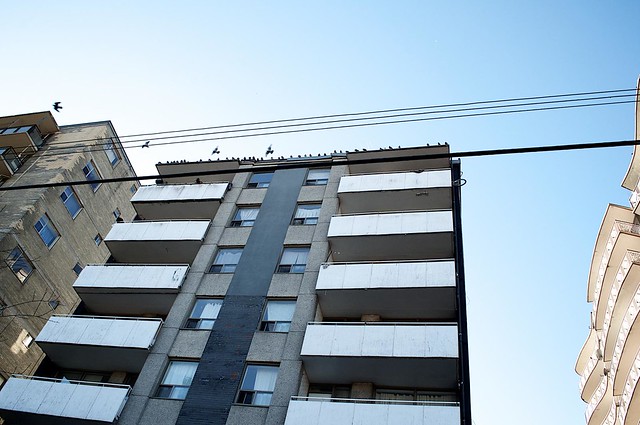
Jameson Avenue didn’t begin to develop until the 1880s, during Parkdale’s brief run as an independent municipality (1879-1889). The Toronto Reference Library’s Parkdale in Pictures offers a nostalgic glimpse of the street during this era. After Parkdale was annexed, Parkdale Collegiate Institute relocated onto Jameson, and was later joined by Queen Victoria Public School. The Grand Trunk Railway opened its South Parkdale railway station in 1879, making Jameson a transit node (the station was demolished in the 1910s). Jameson also became a popular road route in the 1940s for its link to Lake Shore Boulevard and the QEW. The construction of the Gardiner Expressway that followed in the 1950s cost the area many of the homes that had been built at the base of the street, and this demolition began a broader shift from single-dwelling homes to the tall apartment buildings that line the street today. More on Jameson in the broader context of Parkdale’s development is profiled in Carolyn Whitzman’s Suburb, Slum, Urban Village.
While many of these apartment buildings have fallen into noticeable disrepair over the past few decades, the street remains friendly and inviting. During my visit, I also saw construction crews at work repairing balconies and retouching facades on two of Jameson’s towers.

While these construction crews touch up some of the street’s apartment buildings, artist James Bravo and photographer Kate Young spent last year improving its sidewalks with their art project, Impressions. Each of the street’s 70 new tree planters includes eight photographic tiles — a total of 560 photographs. These pictures combine snapshots of current residents as well as new and archival photos of the streetscape. Bravo notes that the photos of Jameson locals mimic passport-style portraits as a nod to the street’s appeal to new immigrants. Duncan’s City Ride features a number of great pictures of Bravo and Young’s work. The project was supported by both the City’s Clean and Beautiful City initiative and by the not-for-profit organization Mural Routes, which works to promote wall art. Mural Routes identifies Impressions as “one of the largest outdoor photographic installations found anywhere in North America.” Bravo and Young’s work is ideal art for a neighbourhood: subtle, but storied and sincere. It both reflects and adds to Jameson’s community identity.
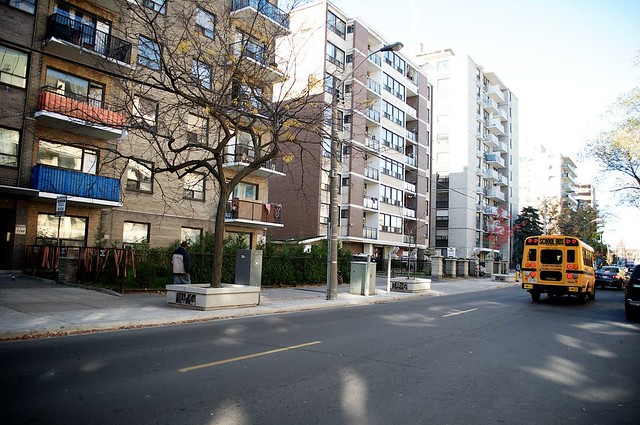
That said, there still appear to be some troubles balancing the various cultural identities that come and go in the community. A recent article in The Globe and Mail profiled the recent influx of Roma that have moved in along Jameson on refugee claims. Indeed, the article notes that many locals refer to Jameson Avenue as “the landing strip” for Canada’s newcomers thanks to Parkdale’s inexpensive rents. All the same, the speed at which the area’s Roma population has grown has led to some anxiety over playground cliques in Jameson’s schools and cultural clashes in its apartment buildings. For her part, DiNovo organized a pre-emptive welcoming party in Parkdale, and the Roma interviewed purport to be happily settling into life in Canada and on Jameson.
Perhaps one of Jameson’s nicest amenities is its close proximity to the waterfront. The street connects right to Marilyn Bell Park and the Martin Goodman Trail via a pedestrian bridge (the one that Spacing‘s Matthew Blackett recently criticized as being under-promoted). The City’s Western Waterfront Master Plan [PDF] also acknowledges this pedestrian bridge as “unpleasant.” The Master Plan’s Phase Two Plan (2014-2028) proposes a realigned Lake Shore Boulevard and a pedestrian/cyclist bridge as a “spectacular new entrance into Marilyn Bell Park,” at an estimated cost of $63,000,000.
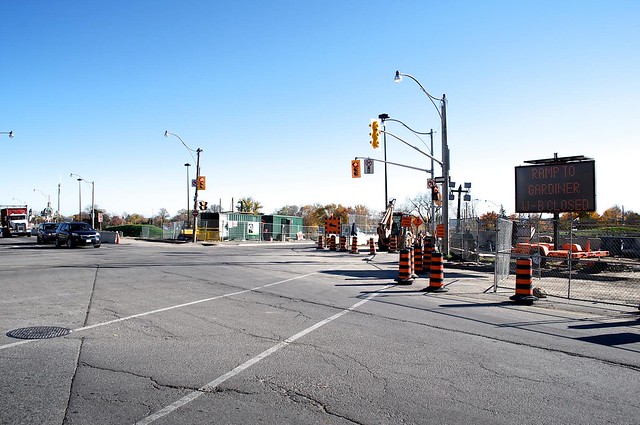
Jameson’s current connections to the Gardiner Expressway and Lake Shore Boulevard make it a busy arterial road for the west, with roadwork currently underway to replace the Jameson overpass for continued car use. Blackett documented the demolition of the overpass with a time-lapse video, while the Toronto Star examined the engineering and financial logistics of the bridge replacement, which is set to be finished November 2011.
Ultimately, it’s fitting that Jameson Avenue should terminate at a bridge; the entire street is itself something of a bridge to the rest of the city. Lined with back-to-back apartment towers, Jameson serves as a home base for many Torontonians, whether they’ve recently arrived or are long settled. Between the street’s Impressions sidewalk art and its lively street scene, it’s easy to recognize Jameson not only for its cumulative street story, but also as a setting for many personal stories.
More photos of Jameson can be seen in our Flickr set.
Street Stories is a regular feature profiling the origins, development and current state of Toronto streets. For more background on the history of Jameson and other Toronto streets, we recommend the excellent book Toronto Street Names. If you have an idea for a street we should feature in an upcoming instalment, email ericmutrie@spacing.ca.

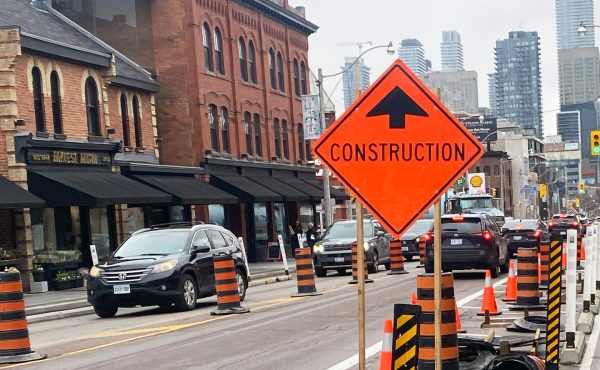
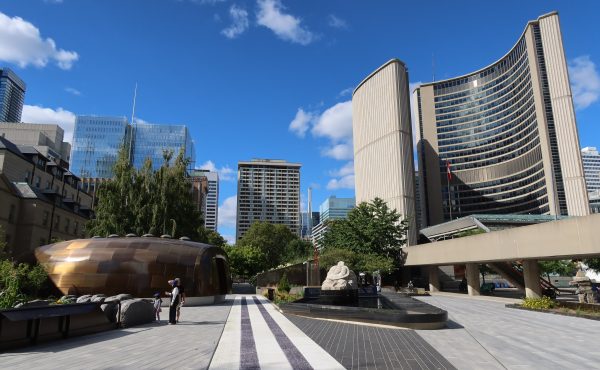

13 comments
Well written and informative. Thank you.
Always love these quick histroy lessions about my city. Thanks for keeping them up.
Author’s comment… “Ultimately, it’s fitting that Jameson Avenue should terminate at a bridge..” No it isn’t fitting, not when that bridge provides the key access point in the downtown west area for the Gardiner and the Lakeshore. I’m sure the people actually living on this street (and I do know some), don’t appreciate having a volume of constant, through traffic in front of their homes (which are actually VERY close to the roadway) that is way beyond what the street was built to handle. Poetic justice does not necessarily make for good planning. As an aside, library archives show that when these apartments were being planned/built (late 50s/early 60s), the developer saw these as upscale units, while critics of the project charged that it would quickly become a low-rent ghetto.
Great article. I’m loving this new series and Eric made a great choice by using such radically different streets as his openers.
Thank you all for the feedback!
samg, I agree that my conclusion may take away from the severity of the problem posed to Jameson by its road links – thank you for adding background on that and Jameson’s apartments to the discussion.
I wish we had more streets lined with midrise apartment buildings and trees like Jameson, albeit with better quality (and better maintained) buildings.
It’s an unusual scale for the city, yet quite interesting. All things being equal, midrise buildings generally have a stronger presence than low-rise buildings, but don’t take up that much land or cast as big shadows on the neighbourhood around them.
The Parkdale South Railroad Station you referred to, which had been on Springhurst Ave. east of Jameson Ave., was demolished around 1910 -1911 when the Grand Trunk tracks were lowered below grade; it was NOT there the 1970’s, that’s for sure! You are probably talking about the North Parkdale Station, which was on a different railroad at a different location; it was located directly across from the Gladstone Hotel, on the tracks, just south of Queen St. W, east of Dufferin Ave.
It’s strange to say this, but I was named after this street. My family made their first home in Toronto on Jameson Avenue. I have no memories of living in Parkdale as my family moved out of there when I was still a baby, but I find myself back here now, as I volunteer in the area.
Parkdalian – thanks for the clarification. I’ve corrected the article to reflect this.
James – an interesting personal “Jameson” story! Thanks for sharing.
Just wanted to mention that all the books mentioned in this article are available to borrow at Toronto Public Library:
Winter Studies and Summer Rambles in Canada
http://www.torontopubliclibrary.ca/detail.jsp?Entt=RDM465578&R=465578
Suburb, Slum, Urban Village
http://www.torontopubliclibrary.ca/detail.jsp?Entt=RDM2472339&R=2472339
Toronto Street Names
http://www.torontopubliclibrary.ca/detail.jsp?Entt=RDM196322&R=196322
Jameson is well known for its bright and competitive Christmas decorations in many of the residentual units.
The November 17 edition of Jack Lakey’s The Fixer column in the Toronto Star discusses one alarming aspect of Jameson that I hadn’t noticed: the street doesn’t have any trash cans.
http://www.thestar.com/news/fixer/article/892520–the-fixer-trash-cans-extinct-on-jameson
The photo that runs in The Star shows a stretch of Jameson’s sidewalk covered in garbage. As my photos show, I didn’t see anything similar during my visit, but the street’s lack of trash cans obviously make litter a likely problem.
Likey reports that Kyp Perikleous–manager of the Public Realm Section at The City–is having staff look into possible locations for trash containers on Jameson, but Perikleous cites the street’s narrowness as an issue.
Jameson Ave. used to have a trash can, until they renovated the planters and sidewalks. Unfortunately it was always over-flowing, but it is missed.
The trash on the sidewalk is also the result of people throwing garbage from the balconies. I have been hit with some rotten fruit while walking, and I am not quite sure why people think that this is a good idea.